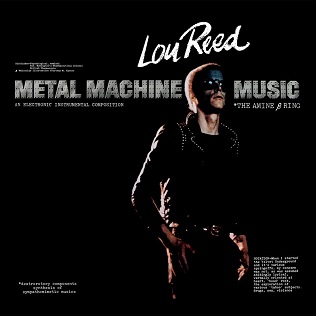
Metal Machine Music
Metal Machine Music (subtitled *The Amine β Ring) is the fifth studio album by American rock musician Lou Reed. It was recorded on a three-speed Uher machine and was mastered/engineered by Bob Ludwig.[1] It was released as a double album in July 1975 by RCA Records, but taken off the market three weeks later.[2] A radical departure from the rest of his catalog, the Metal Machine Music album features no songs or recognizably structured compositions, eschewing melody and rhythm for modulated feedback and noise music guitar effects, mixed at varying speeds by Reed. Also in 1975, RCA released a Quadrophonic version of the Metal Machine Music recording that was produced by playing it back both forward and backward, and by flipping the tape over.[3]
For the 2015 album by Die Krupps, see V - Metal Machine Music.Metal Machine Music
The album cost Reed's reputation in the music industry while simultaneously opening the door for some of his later, more experimental material and has generally been panned by critics since its release. In 2008, Reed, Ulrich Krieger, and Sarth Calhoun collaborated to tour playing free improvisation inspired by the album as Metal Machine Trio. In 2011, Reed released a remastered version of Metal Machine Music.[4][5]
Style[edit]
A major influence on Reed's recording, for which he tuned all the guitar strings to the same note,[6] was the mid-1960s drone music work of La Monte Young's Theatre of Eternal Music,[7][8] whose members included John Cale, Tony Conrad, Angus MacLise and Marian Zazeela.[9] Both Cale and MacLise were also members of the Velvet Underground (MacLise left before the group began recording).
The Theatre of Eternal Music's discordant sustained notes and loud amplification influenced Cale's subsequent contribution to the Velvet Underground in his use of both discordance and feedback. Recent releases of works by Cale and Conrad from the mid-sixties, such as Cale's Inside the Dream Syndicate series (The Dream Syndicate being the alternative name given by Cale and Conrad to their collective work with Young) testify to the influence this mid-sixties experimental work had on Reed years later.
In an interview with rock journalist Lester Bangs, Reed stated that he "had also been listening to Xenakis a lot." He also claimed that he had intentionally placed sonic allusions to classical works such as Beethoven's Eroica and Pastoral Symphonies in the distortion, and that he had attempted to have the album released on RCA's Red Seal classical label. He repeated the latter claim in a 2007 interview.[10]
Performance[edit]
Lou Reed did not perform Metal Machine Music on stage until March 2002, when he collaborated with an avant-garde classical ensemble at the MaerzMusik festival in Berlin. The 10-member group Zeitkratzer performed the original album with Reed in a new arrangement by Ulrich Krieger, featuring classical string, wind, piano, and accordion.[28] Live recordings with (2007) and without (2014; all-acoustic) Reed are available commercially.[29]
A few years later, Reed formed a band named Metal Machine Trio as a noise rock/experimental side project.
In popular culture[edit]
The language of the Star Trek aliens known as the Breen was inspired by Metal Machine Music, which the post-production sound staff were instructed to listen to when creating the electronic cackle that served as the Breen's voices.[30]
On Mystery Science Theater 3000, Joel Hodgson's character likened watching Mighty Jack to "listening to two hours of Lou Reed's Metal Machine Music."
Later on Mystery Science Theater 3000 Michael J. Nelson's character says "Monster gets up and immediately puts on his Metal Machine Music" due to the background music during the mutation scene in The Horror of Party Beach.